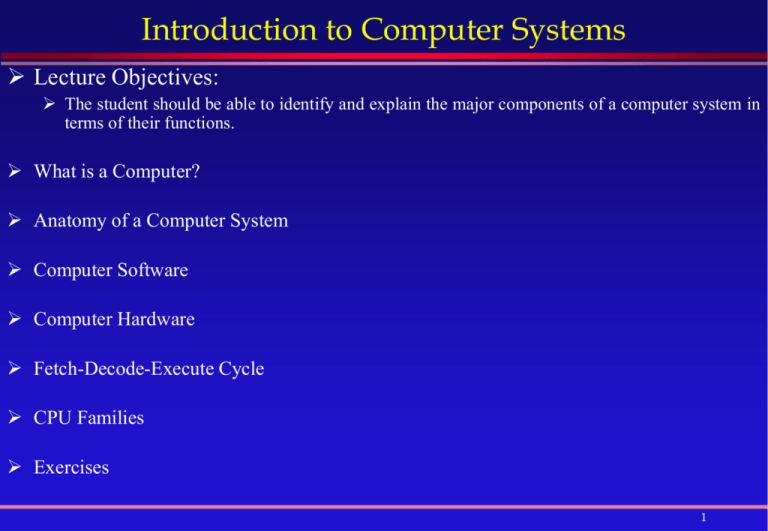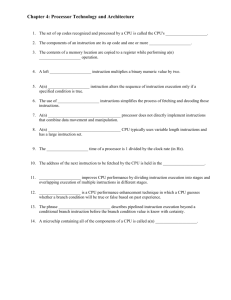Introduction to Computing
advertisement

Introduction to Computer Systems Lecture Objectives: The student should be able to identify and explain the major components of a computer system in terms of their functions. What is a Computer? Anatomy of a Computer System Computer Software Computer Hardware Fetch-Decode-Execute Cycle CPU Families Exercises 1 What is a Computer System? A computer system is an electronic device which can input, process, and output data input processing output memory Input data of a computer may represent numbers, words, pictures etc Programs that control the operations of the computer are stored inside the computer 2 Major Components of a Computer System A computer system consists of two main parts: hardware and software Hardware is the physical components and software is the non-physical components of a computer system. Computer hardware is divided into three major components: 1. Input/Output (I/O) devices 2. Computer memory 3. The Central Processing Unit (CPU) Computer software is divided into two main categories: 1. Systems software 2. Applications software 3 Systems Software System software manages computer resources and makes computers easier to use Systems software can be divided into three categories: 1. Operating System (OS) Examples: Windows, UNIX and Macintosh 2. System support software Examples: disk-formatting and anti-virus programs. 3. System development software. Example: Language translators. 4 Applications Software An applications software enables a computer user to do a particular task Example applications software include: Word processors Game programs Spreadsheets (or Excel sheets) Database systems Graphics programs Multimedia applications 5 Computer Hardware 6 I/O (Input/Output)Devices Input devices are used to enter programs and data into a computer. Examples: keyboard, mouse, microphone, and scanner. Output devices are where program output is shown or is sent. Examples: monitor, printer, and speaker. I/O devices are slow compared to the speed of the processor. Computer memory is faster than I/O devices: speed of input from memory to processor is acceptable. 7 Computer Memory The main function of computer memory is to store software. Computer memory is divided into primary memory and secondary memory. Primary memory is divided into random access memory (RAM) and readonly memory (ROM): The CPU can read and write to RAM but the CPU can read from ROM but cannot write to ROM RAM is volatile while ROM is not. Secondary memory Examples of secondary memory devices are: hard disks, floppy disks and CD ROMs 8 Primary Memory 9 The CPU The CPU is the "brain" of the computer system. The CPU directly or indirectly controls all the other components. The CPU has a limited storage capacity. Thus, the CPU must rely on other components for storage. The CPU consists of: 1. 2. 3. The Arithmetic and Logic Unit (ALU). The Control Unit (CU). Registers. The CPU components are connected by a group of electrical wires called the CPU bus. 10 The CPU (cont’d) 11 Fetch Decode Execute Cycle The CPU continuously transfers data to and from memory Data transfer is done in units called instructions or words When a computer is switched on, the CPU continuously goes through a process called fetch-decode-execute cycle: The Control Unit fetches the current instruction from memory, decodes it and instructs the ALU to execute the instruction. The execution of an instruction may generate further data fetches from memory The result of executing an instruction is stored in either a register or RAM 12 Fetch-Decode-Execute Cycle (cont’d) Instruction Cycle Main Memory Control Unit 1 Fetch 2 Decode cpu RAM 4 Store 3 Execution Cycle Execute Arithmetic/Logic Unit 13 CPU Families Different people understand different natural languages. Similarly each processor family understands its own machine language. The fundamental difference between computers that are not compatible is in their processors. Here are some CPU families: Pentium Power PC SPARC The question now is: Is it possible to write a single program that can be understood and correctly executed on machines with different processors? We’ll address this question in a subsequent lecture. 14 Drill Questions 1. Write short notes explaining the functions of each of the following 1. Computer memory 2. The CPU 3. Computer software 2. I/O devices can be used to input into and output from a computer system. Then, is computer memory necessary? Explain. 3. Since the OS controls the hardware and software in a computer system, which programs control the loading of an OS onto a computer system? 4. The system bus consists of three buses. Mention them and explain each of them briefly. 5. Since different CPUs understand different instructions, how are we able to exchange information between machines with different CPUs? 15






